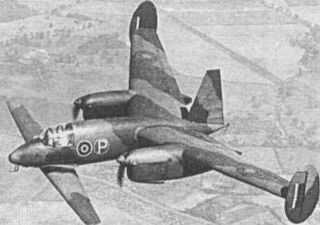
The M.39B Libellula was a Second World War tandem wing experimental aircraft built by Miles Aircraft, designed to give the pilot the best view possible for landing on aircraft carriers. A scale version of the M.39 design was proposed by Miles to meet Air Ministry specification B.11/41 for a fast bomber. The M.39B was used by Miles to generate data from which the M.39 design was improved, but the M.39 project was cancelled and the M.39B broken up.

The Miles M.38 Messenger is a British four-seat liaison and private owner aircraft built by Miles Aircraft.
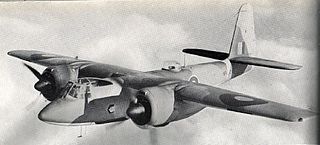
The Miles M.33 Monitor was a twin-engined British target tug aircraft designed and built by Miles Aircraft towards the end of the Second World War. Intended for use by the Royal Air Force and the Fleet Air Arm, the aircraft did not enter service with either.
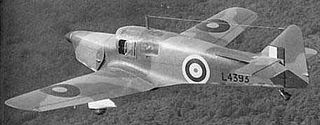
The Miles M.16 Mentor was a 1930s British single-engined three-seat monoplane training and communications aircraft built by Miles Aircraft Limited.

The Miles M.17 Monarch was a British, light, touring aeroplane of the 1930s. It was a single-engine, three-seat, cabin monoplane with a fixed, tailwheel undercarriage.

The Miles M.28 Mercury was a British aircraft designed to meet the need for a training and communications plane during the Second World War. It was a single-engined monoplane of wooden construction with a twin tail and a tailwheel undercarriage with retractable main units.

The Miles M.12 Mohawk was a 1930s British two-seat, tandem cabin monoplane built by Phillip & Powis Aircraft to the order of Charles Lindbergh in 1936. After being used by Lindbergh in Europe it was impressed into service with Royal Air Force as a communications aircraft in 1941.

The Miles M.2 Hawk was a twin-seat light monoplane designed and produced by the British aircraft manufacturer Miles Aircraft Limited during the 1930s. It is the first of the company's aircraft to attain quantity production.

The Miles Hawk Trainer was a 1930s British two-seat training monoplane designed by Miles Aircraft Limited.

The Miles M.1 Satyr was a 1930s British single-seat aerobatic biplane designed by F.G. Miles and built for him by George Parnall and Company.

The Miles M.4A Merlin was a 1930s British five-seat cabin monoplane built by Miles Aircraft Limited.

The Miles M.5 Sparrowhawk was a 1930s British single-seat racing and touring monoplane designed by Miles Aircraft Limited.
The Miles M.6 Hawcon was a 1930s British experimental monoplane designed by Miles Aircraft Limited. The Hawcon name comes from a combination of Hawk and Falcon.

The Miles M.7 Nighthawk was a 1930s British training and communications monoplane designed by Miles Aircraft Limited.
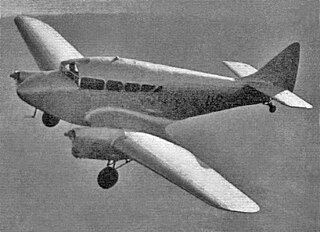
The Miles M.8 Peregrine was a 1930s British twin-engined monoplane light transport designed by Miles Aircraft Limited. A promising design, the Peregrine never entered production as the company was preoccupied by fulfilling orders for other types to the RAF. Only two of the model were built, one prototype M.8 Peregrine, and one modified M.8A Peregrine II which was used for experimentation work at Royal Aircraft Establishment.
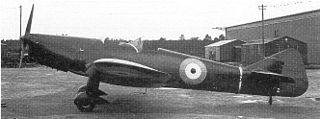
The Miles M.15 was a 1930s British single-engined monoplane trainer aircraft with two open cockpits, designed and developed by Miles Aircraft. Like other aircraft constructed to the official specification, it failed to meet the performance requirements, and only two were built.
Miles M.26 was the designation used to cover the family of X-series design proposals, for long-range transport aircraft. The common factors of most X design proposals were the use of a blended wing body and engines buried in the wings, based on principles patented by Nicolas Woyevodsky. A sub-scale prototype of the X.9 proposal was constructed, designated the Miles M.30.
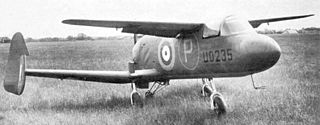
The Miles M.35 Libellula was a tandem wing research aircraft built by Miles Aircraft as a precursor to a proposed naval carrier fighter. It was named after the Libellula, a genus of dragonflies.
The Miles M.64 L.R.5 was a two-seat light aircraft, designed in the United Kingdom, for private and club use in 1944-1945.
The Hurel-Dubois Miles HDM.105 was a transport aircraft fitted with very high aspect ratio wings for research purposes, building on research carried out with the Hurel-Dubois HD.10, and a stepping point to the planned production HDM.106 Caravan. The HDM.105/HDM.106 provided the starting point for the design of the Short SC.7 Skyvan.
















